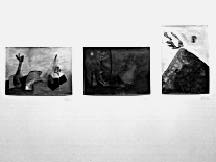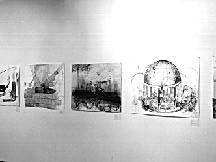- MAIN INDEX | ARTIST INDEX
| November 20 - December 15, 1984 Two person exhibition: Laszlo Révész, Andras Böröcz Curated by Nina Czegledy | |
 Laszlo Révész, installation view of works on paper, 1984. Photo Peter MacCallum. 18K |  Andras Böröcz, installation view of works on paper, 1984. Photo Peter MacCallum. 18K |
| PRESS RELEASE Laszlo Révész and Andras Böröcz, two visiting artists from Budapest featured in this exhibition, express their concepts through a complex variety of art forms. Révész and Böröcz are concerned with working through principles common to the current global movement of performance art. The direction is one which attempts to revive the tradition of classical 'happenings' and performances dating back to the beginning of this century, and the creation of a contemporary medium, through performance art, which balances scientific principles with components of stage art and live sound. The multi-directional approach of Révész and Böröcz is given expression in Toronto through the current exhibition at Mercer Union, a performance at The Rivoli, and a screening of their films at The Funnel. For the most part, there exists a continuous interchange between their visual art and performances, with concepts of one medium alternately influencing the other. Occasionally, their paintings are totally divorced from concepts explored in their performance work. Examples of this conceptual interchange are illustrated in this exhibition through the independent themes of Révész's paintings in contrast to Böröcz's work, which centres mostly on recent performances. Both Andras Böröcz and Laszlo Révész live and work in Budapest. In 1981 they graduated from the Fine Arts Academy in Budapest, which was followed by one year of post-graduate work at this Academy. They have collaborated on seventeen performances, and continue to exhibit widely, having previously shown their work in Italy, Finland, Germany, Austria, Yugoslavia, and Budapest. Their visit to Canada has been made possible through the assistance of the Canada Council's Visiting Foreign Artists Programme, in cooperation with the Department of External Affairs. In addition to the above mentioned events staged to coincide with their exhibition, the artists will tour on a national lecture/workshop series. FACT SHEET Names: Laszlo Révész and Andras Böröcz VISITING HUNGARIAN ARTISTS
Events: November 20 through December 15, 1984 Curated by Nina Czegledy Opening November 20, 8:00 pm. Gallery hours: Tues. - Sat. 12-5 November 21, 8:00 pm Film Screening at The Funnel, 507 King Street East, Toronto. Featuring an evening of Hungarian films, with films by Laszlo Révész and Andras Böröcz based on their performance pieces, in addition to those by other contemporary Hungarian artists. The artists will present to discuss their work. Admission is $3.50 Free to members. November 26, 8:00 pm Performance by Révész and Böröcz at The Rivoli, 334 Queen Street West, Toronto. Admission Free. Sponsors: Mercer Union, through the Canada Council Visiting Foreign Artists Programme, in cooperation with the Department of External Affairs. Acknowledgments: The Ontario Arts Council, the Toronto Arts Council, The Municipality of Metropolitan Toronto and the Canada Council. Additional Events: National lecture/ workshop series Révész and Böröcz will tour Canada workshops, slide presentations and at various educational institutions giving lectures, film screenings.
Laszlo Révész
Nancy Merritt Bell The immediate fascination with Laszlo Révész and Andras Böröcz was not their art, but their lives as young artist's from Budapest - from "Behind the Iron Curtain". Both Böröcz and Révész were overwhelmed by questions regarding politics and censorship. Révész (whose command of English is excellent, and even enviable) dissuaded me from pursuing the subject of Eastern Block Communist: "...we are much freerer. After all, I am here...I am not political. I like people. I want people to talk, and to laugh. Politics is such a small part of this", he said, gesturing to his work, and then including the room full of people talking, arguing and laughing. Art history and Mythology and common objects such as matches and oranges and cigarettes are the subjects of their works on paper. Révész's paintings explore simple forms smearing into each other; one form gives over to another to become a whole and new form in composition. The few figurative works are particularly dynamic as they capture emotionally charged moments in rich colours which give depth to the tentative quality of his work. The success of these dramatic paintings owes to Révész's fascination and experience with Theatre and Cinema. Andras Böröcz is the more accomplished of the two; his series of mixed media drawings possess a strong narrative quality more closely akin to (if not actual studies for) the performance pieces. His treatment of the subject matter is unexpectedly amusing: In 'Mozart Don Juan', Marie Antoinette, Mozart and Don Juan are all conceived as potted cacti. These quasi-historical characters are reduced to comic absurdity and further diminished by the bizarre landscape (composed of two islands - one inhabited by a band of women all enshrined by helmet-style hair dryers and the other island a graveyard). The general impression of black and white cartoon sketches belies the subject matter and the bitter-sweet statement. These Icons of Culture and History are so comically out of place they become a satire on Traditionalism and the Technological society. It is this comic intention that distinguishes Böröcz and Révész from not only their own generation of emerging artists but also from the past ten years of Avant-Garde Hungarian Art. "They are all serious. Serious!" Révész repeats the word and pulls a long face to dramatise his point. The most recent trends in visual and performance art of Budapest favours confrontation forcing the questioning of values and of existence and often posing answers. The supporters of this bleak and serious-minded current denounce Révész's and Böröcz's work as elitist and frivolous . However the growing audience and governmental support (for both Révész and Böröcz are recipients of the prestigious Derkovits Scholarship) clearly indicates the importance and the need for their work. Their humorous and somewhat self deprecating approach gives the viewer a new vantage point that is distinctly refreshing. The diverging styles exhibited in their works on paper belies the close working partnership of Böröcz and Révész. Their series of films screened at The Funnel November 21 1984 are primarily based on their seventeen performance pieces. The general format of these films is an exploration of a common object through a series of different contexts with Révész and Böröcz acting as catalysts. The Globe: Einstein and Frankenstein looks at the sphere shape: an orange, a round lottery ticket (peculiar to Budapest) heads eyes and space helmets. The appreciation for this natural shape is renewed and the desire to emulate the sphere elicits sympathy (and a few snickers) when the two artists travel to a sand quarry to fashion out a globe shape - and then sit in it and smoke. In Matches the two artists literally become matches donning match boxes and striking each other. As the subject becomes increasingly remote from its familiar place a new world of Matches is created - which makes even the most casual cigarette puff significant. Through close observation of these everyday objects the banal becomes elevated to the symbolic. The performance of "Odysseus" at the Rivoli November 26 exceeded the expected format the transubstantiation of common objects and presented a charming microcosm of the world of Art and History. The black and white stencilled guillotines, the styrofoam horseshoes and blocks suspended over the playing area the two powdered-wigged ladies bouncing the hung objects with their fans to the classical music eked out by two tuxedoed musicians - all suggested a pristine world of Art and History that is flat and ineffectual. This desecration was taken to it's most ridiculous extreme when the two ladies forced a pair of watermelons through holes onto a two dimensional styrofoam table. This physical transposition of objects belonging to a real three dimensional world on to the flat plane of the artists construction served to further expose the perceptual limitations of this pristine world. The appearance of Böröcz and Révész as mock centaurs wearing enormous paper-mache horse bodies was at once intimidating and hysterically funny. Although they liberated the stage of the stifled Classical worlds cutting the objects and shoeing each other with their remains and smearing away the guillotines with coffee drenched shirts they made an anarchic mess while swatting the other performers with their centaur tails. Böröcz and Révész defied the traditional expectation of the gallant hero-artist possessing a rather workman-like quality of buffoonery. The climax of their comic dissembling was to saw down a ladder it being too tall for their purposes: the ladder broke and the two artist-centaurs fell to the ground. After devaluing Art Révész and Böröcz devalued themselves as artists as agents of change. Both Révész and Böröcz draw their vocabulary of images from their formal education in Budapest where Latin Mythology and Art History are very much a part of the curriculum and from Hungary itself. There the past still seems to live: Mediaeval churches stand beside new factories. For Révész history is very much alive and refreshing as he says ...it takes me out of myself . However he does not believe Hungary is trapped by its past: Italy has a terrible burden of Art History. They cannot always live up to the Renaissance. Here the duality of the historical references and Classical forms of art present in their work becomes apparent as something cherished but not always vital. This duality is essential to understanding their work in which the banal is exalted and the Classical forms reduced but for no obvious definitive statement. Their art is not conclusive - rather like a Happening their performance as a cumulation of all their artistic efforts is a presentation designed to alter perceptions so that values and expectations may be more readily identified - so that something new might happen .
| |